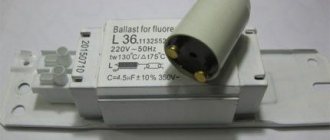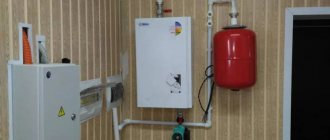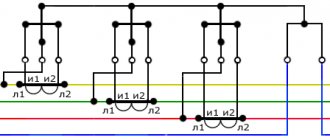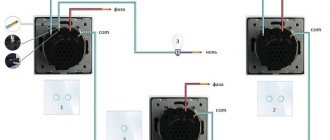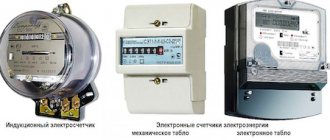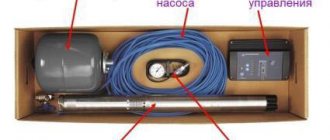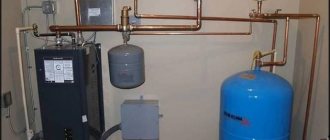Installing a special device for controlling the heating level of an autonomous heating system in a private home reduces fuel consumption by 20%, reduces the load on equipment and increases indoor comfort. Let's look at what a thermostat for a heating boiler is, how it works and what it is intended for, what types of it exist, how to choose the right one for specific application conditions and what are the features of its connection.
Digital room thermostat for heating boiler Source gradusplus.com
Thermostat - what is it, purpose, principle of operation
The thermoregulatory device interacts between the heating heater and the temperature of the atmosphere indoors and outdoors, as well as the level of heating of the coolant, pipes and radiators. In this case, the parameters are set by the user through the control unit.
A typical thermostat consists of the following set of main components:
- Thermosensitive sensor. It is made of a material that changes characteristics under the influence of changes in ambient temperature. The signal from the sensor is transmitted to the control unit.
- Control module. It detects the slightest changes in sensor parameters and issues the appropriate command to the operating mechanism, which directly triggers one or another action in the boiler equipment. This can be a simple mechanical valve or an electromagnetic relay, as well as a digital or analog device.
A temperature-sensitive element connected by a wire to the actuator unit Source par-torg.com
- Settings block. On it, the user sets the temperature values and other parameters at which the thermostat for the heating boiler should operate. In mechanical models, one single setting is performed, in electronic models, several parameters are set simultaneously.
The device operates according to the following algorithm:
- Using the settings block, the user sets the required temperature value.
- As soon as the heating level of the medium reaches the desired value, the control module detects the changes that have occurred in the characteristics of the sensor.
- Next, a signal is sent to the operating mechanism to perform a specific action - stopping the boiler, closing the pipeline valve, shutting off the radiator, etc.
- As the ambient temperature reaches below the set value, the control unit again records the changes in the sensor and starts the system to increase the temperature.
Advice! During the absence of the owners or during night sleep, using a programmable thermostat, you can lower the temperature in the house by 3-4 0C below the normal value. This will reduce energy consumption by 30% compared to the usual consumption rate.
The thermostat ensures a comfortable microclimate in the house no matter the weather surprises Source stroy-podskazka.ru
Why do you need a stabilizer for an electric boiler?
A voltage stabilizer is an automatic device for electric heating boilers, which, like a thermostat, allows you to save money. But in this case, we are not talking about efficient energy consumption, but about the integrity and performance of the heating element as a whole.
A stabilizer for an electric heating boiler allows you to smooth out all differences in the operating characteristics of the electrical network during the day and obtain the correct sinusoidal voltage at the output, which will have a beneficial effect on the durability of the boiler. Stabilizers provide a high degree of protection of electrical appliances from ripple and voltage surges. High-quality equipment is highly sensitive, which is important for the electronic part of the boiler and thermostat. Stabilizers are characterized by an increased margin of network output power. This allows you to maintain the operating characteristics of the electrical network at the proper level even when the boiler is turned on.
Before purchasing a stabilizer, you must consult a specialist and clearly determine the type of equipment needed and its power.
Varieties
Household temperature sensors for heating boilers are classified according to several criteria:
- Method of temperature control – mechanical, electromechanical, electronic.
- Boiler type – for electric, gas, solid fuel.
- Installation location - indoor, outdoor.
- Signal transmission method - wired, wireless.
- Number of functions – with one, many (programmable).
Let's look at the features of each variety in more detail.
By temperature control method
Depending on the method by which transformations of the properties of a temperature-sensitive component are transmitted in response to changes in ambient temperature, temperature sensors are divided into the following 3 types:
- Mechanical.
The operating principle of sensors of this type is based on changes in the physical properties of substances under the influence of heating or cooling - namely:
- Expansion-compression of gas or liquid.
- Fluctuations in metal elasticity parameters.
The design of devices with liquid or gaseous substances is based on a sealed flask. When the heating level changes, the liquid or gas contracts or expands, thereby moving the valve stem or gate. The operation of models based on a metal element is based on the closing and opening of contacts. When heating and cooling, the plate is deformed - supplying or interrupting an electrical signal to the control module.
The main advantages of a mechanical temperature controller for a heating boiler:
- Independence from the state of the external power supply network.
- Simple device and simple design.
- Low cost.
The negative aspects of this type of regulator are expressed in low sensitivity, a fairly noticeable error - up to 20C and bulkiness. Most often they are installed to control the temperature of the coolant in the radiator, but not the air in the room.
To set up a mechanical thermostat, just turn the knob to the desired position Source terman-s.ru
- Electromechanical. The operating principle of this type of regulator is based on the occurrence of a potential difference between interconnected plate elements made of different metals. The signal from them passes to an electromagnetic relay to execute a specific equipment command. Due to low sensitivity, high surface heating is required to obtain a sufficient electrical impulse.
Therefore, their main area of application is flame control in the furnace of a boiler operating on direct combustion of fuel. As soon as the fire goes out, a signal instantly passes to the control unit and security system. At the same time, the device requires constant power supply to operate.
- Electronic. Temperature regulators that require a constant power supply for full operation. They contain an external temperature-sensitive element for monitoring air temperature and a control module. As a rule, electric boilers are equipped with them.
The electronic boiler temperature sensor includes 2 main components:
- Thermosensitive element.
- Microcontroller.
See also: Catalog of companies that specialize in engineering systems (heating, water supply, sewerage and others) and related work
Having received a signal from the sensor, the microcontrolling module executes one or more commands programmed into it. In this case, both elements may not necessarily be located in the same housing, but are separated from each other in space. Communication between them is carried out both wired and wireless.
Depending on the type of technology used, there are two types of electronic sensor:
- Analog. Works according to a strict logical algorithm. The capabilities are similar to mechanical models, but more accurate - the error is no more than 0.5 °C.
- Digital. It operates in both closed and open logic circuits. In the latter case, it allows you to make custom settings and set heating parameters according to a schedule.
Advantages of an electronic sensor:
- Connection of remote sensors, including street ones.
- Highly precise settings.
- Variety of execution options.
Disadvantages: energy dependence and high price.
The electronic temperature sensor is quite accurate, but requires constant power supply Source teploregulyator.ru
On a note! Modern models of electronic sensors can be controlled remotely via a mobile application when connected to a smart home system. For example, you can set the desired level of room heating after a long absence when returning home from work, a trip, or vacation.
By boiler type
Despite the fact that all types of heating boilers are designed for one common purpose - heating rooms, they operate, and therefore are controlled, according to slightly different schemes. Therefore, different thermostats are used for them, having the following features:
- For gas. The thermostat for a gas boiler, as a rule, has a built-in design and is designed to control the temperature of the coolant. However, copies of some lines have the ability to connect external sensors to measure the heating of the surrounding air. The influence of a particular sensor on the operation of the unit is set by the control module depending on the settings.
In addition, it is possible to connect an external thermostat in parallel with the built-in one - without a special interface according to the following algorithm:
- The executive module is integrated into the electrical power supply circuit of the unit.
- After this, the required room temperature is set on the sensor.
- When the air temperature reaches the set value, the executive unit will de-energize the boiler.
- As it cools, the thermostat will start the burner.
Gas units in non-volatile design are always equipped with mechanical temperature sensors of the remote type. They only control the operation of the burner. Some models may be equipped with a standard external sensor without the possibility of replacement or addition.
- For electric ones.
Unlike the type of unit described above, the electric boiler is controlled in a large number of ways:
- By disconnecting the power supply.
- Changing the intensity of operation of electric heating elements.
- Impact on the controller.
External thermostat for an electric boiler Source onlinetrade.ru
We achieve maximum stability and comfort
An additional feature of many electronic thermostats is the ability to organize weather-dependent control, when the boiler power is adjusted, including changes in the outside temperature. To do this, just connect a universal outdoor temperature sensor to the thermostat (2-2.5 thousand rubles).
External temperature sensor for Gira thermostat 130200.
It consists of a single structure: a sensor and a wire 2-6 m long. Therefore, it is enough just to fix the wire strands in the corresponding contacts of the thermostat, according to the instructions.
Video description
Video example of installing and using a smart thermostat for a boiler:
Helpful information! The thermostat should be mounted in a place to prevent it from being exposed to nearby heating devices, sunlight, drafts, cold bridges, electrical equipment, at a height of about 1-1.5 m from the floor surface.
By signal transmission method
Medium heating meters for a heating unit are divided into 2 types according to the method of data transmission:
- Wired. Connect to the controller via cable.
- Wireless. Data transmission is carried out via a radio channel, and goes from the unit that controls the parameters of the room, that is, the temperature sensor itself, to the receiver unit installed near or on the body of the unit.
Helpful information! In addition to room air heating regulators, there are temperature sensors for measuring the heating level of the coolant used in the heating system. They are produced in overhead and submersible versions. The first ones are installed on the surface of the pipeline and batteries, the second ones are mounted in a special place inside the pipes, and during operation they come into direct contact with the heated liquid medium.
Selection rules
When choosing a temperature sensor for a heating boiler, the following installation parameters are taken into account:
- How, where and in what way the regulator will be installed.
- Maximum permissible dimensions.
- Operating range of control and regulation of temperature indicators.
- Sensitivity limit.
- Intended purpose for installation - outdoor, indoor, overhead or submersible.
- Basic and additional functionality.
- Control options – via panel, remote control, remotely.
How to choose a thermostat
When visiting a specialized store, you should pay attention first of all to the following points:
- Connection.
- Mounting method.
- Functionality.
- Availability of Wi-Fi or GSM modules.
- Safety.
- Protection.
Most models can boast of good characteristics, the range of goods is also large, each owner can quite easily choose an item that will best satisfy his wishes.
Connection features
There are 3 standard schemes for connecting a temperature sensor to a heating boiler - these are:
- Directly to the boiler.
- To the pump.
- In front of the radiator on the pipe.
The first two options do not reduce the power of the coolant flow, unlike the third. In the latter case, the thermostatic valve somewhat impedes the flow, thereby increasing the hydraulic resistance in the system. This must be taken into account - since the pipes are designed for a certain maximum pressure.
To avoid an accident, it is necessary in advance - even at the design stage - to include in the circuit all thermostats mounted on pipes and radiators. In addition, it is recommended to install a temperature sensor in front of the battery using a bypass. With its help, the flow will be redirected to the return line while not cooled down - thereby saving energy resources.
Briefly about the main thing
The thermostat controls the operation of the heating unit in accordance with the user’s settings - based on the air temperature indoors and outdoors, as well as the heating level of the radiators and coolant in the system. Its design includes a temperature-sensitive element, a control module and a settings unit.
As soon as the temperature of the controlled environment reaches the set value, the executive unit sends a command to the equipment - turning off the boiler or pump, closing the valve in the pipe. As it cools down, the reverse command is triggered - the equipment turns on for heating.
Modern models of temperature sensors for heating are classified according to the following criteria:
- Thermal control method.
- I see the boiler.
- Installation location.
- Data transfer method.
- Number of functions.
When choosing a regulator for specific application conditions, first of all, its own technical characteristics and their compatibility with the equipment are taken into account. Installation of devices is carried out in three ways - to the boiler, to the pump and to the pipes. Moreover, their introduction into the scheme should occur at the stage of project creation.
